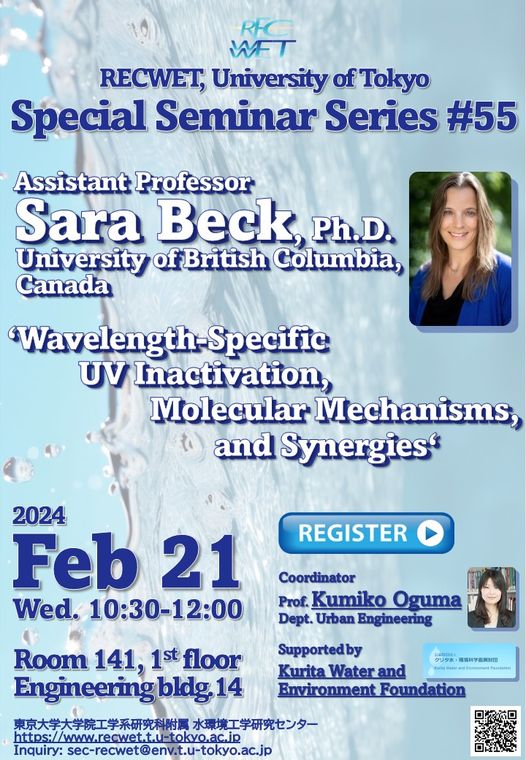RECWET Special Seminar Series #55

'Wavelength-Specific UV Inactivation, Molecular Mechanisms, and Synergies'
By: Assistant Professor Sara Beck, Ph.D.
Department of Civil Engineering, University of British Columbia, Canada
Profile
Google scholar
Date and Time: 10:30-12:00, Feb 21(Wed), 2024
Place: Room 141 (1st floor, Engineering building 14)
Coordinator: Professor Kumiko Oguma, Dept. Urban Engineering
Supported by Kurita Water and Environment Foundation (KWEF)
Remarks: Free of charge, Anyone can participate

[Lecture Report] Dr. Sara Beck, the lecurer / Venue and participants / Prof. Kumiko Oguma, the coordinator
[Lecture Abstract]
This research, spanning over a decade, assessed the wavelength-specific effects and molecular mechanisms of germicidal ultraviolet (UV) irradiation on microorganisms including bacteria, viruses, and helminth eggs. Every organism has a unique spectral sensitivity to UV irradiation, called its action spectra. Using the gold standard of UV disinfection experiments, a tunable laser, we measured the action spectra of several organisms at 10 nm intervals, including Cryptosporidium, adenovirus, MS2 and several other bacteriophages. These measurements directly influenced the disinfection guidelines for polychromatic UV disinfection in the United States, Canada, and Japan.
At the molecular level, the spectral sensitivity of bacteria strongly correlates with their DNA or RNA absorbance. For many viruses, however, the sensitivity deviates from the UV absorbance of their DNA or RNA since damage to viral proteins plays a significant role in the UV-induced inactivation, particularly at low UV wavelengths. For other microorganisms, exposure to two UV wavelengths in series leads to a synergistic effect on the microorganism, more than doubling the inactivation. This talk will shed light on which wavelengths, or combinations of wavelengths, can be most effective for certain applications, and why.
[About her research]
Dr. Sara Beck and her research group at the University of British Columbia specialize in waterborne pathogen disinfection and water treatment processes with the goal, first, to gain a fundamental understanding of what is occurring on a microbial or molecular level and, second, to use that knowledge to prevent pathogen transmission. Working at the confluence of public health, water quality and innovative water treatment solutions, she and her team use microbiology tools to improve water treatment and reuse processes and bridge the gap between knowledge and practice.
